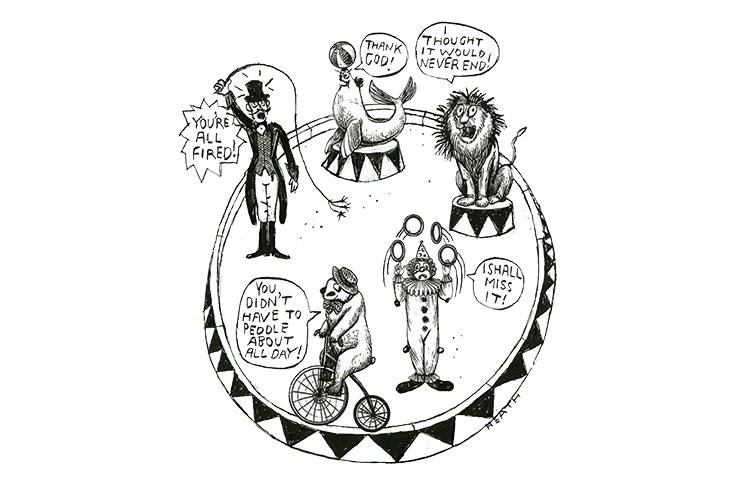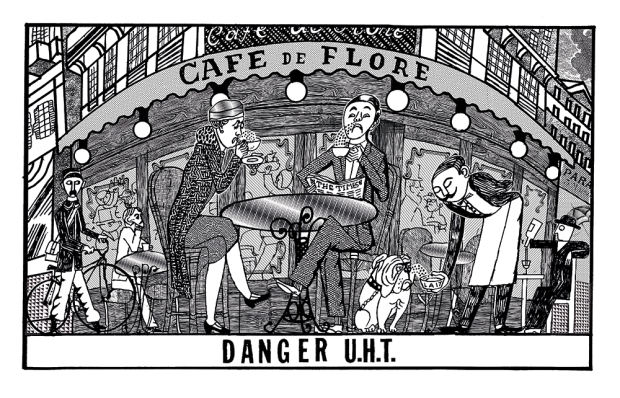In a British circus, you will no longer find big cats, dancing bears or sea lions balancing on balls. Anne, the last elephant, paraded around the ring for the final time almost a decade ago, after a circus career lasting more than 50 years.
The only wild animals that continue to perform under the big top are a fox, three camels, three raccoons, four zebra, half a dozen reindeer, a zebu, and a macaw called Rio. This menagerie travels with two small family–run traditional circuses, Circus Mondao and Peter Jolly’s Circus.
Almost a million pounds have been spent on each animal, trying to get them banned from performing. The mighty Royal Society for the Prevention of Cruelty to Animals (RSPCA) has been running this campaign, alongside the Born Free Foundation, PETA and the militant group Animal Defenders. Earlier this year, the British government announced a ban on all wild animals in travelling circuses by 2020.
Circus wasn’t built on wild animals, but on the horse. In 1768, 250 years ago this year, on an abandoned patch of marshland near London’s Waterloo, the retired cavalryman Philip Astley and his wife Patty laid out a rope in the shape of a ring. They filled this magic circle with astounding street acts — tumblers, jugglers, acrobats, clowns.
The size of this ring was determined by the horses. After experimenting, the Astleys found the best diameter was 42ft. This allowed riders to stand on horseback and canter around, using centrifugal forces to keep them upright. Every circus ring since has measured the same. (There were some other animals in this first circus: a swarm of bees. Patty’s trick was to ride around the ring smothered in them as if wearing a giant muff.) It wasn’t until over half a century later, with the arrival of the American menagerie, that wild animals were introduced to the British circus.
In a circus, Rio the macaw counts as a wild animal, so he needs to be licensed. But you can also buy a macaw without a licence on the internet. Search and you’ll find plenty: ‘Beautiful macaw parrot. Starting to talk and dances. Will go on your hand and lets you cuddle him and play with him. No time wasters.’ A cage will cost you around £70 from Amazon — ‘ideal for narrow boats and caravan trips’. Anyone can take a pet macaw away on holiday with them in their motorhome. Yet the same bird will be banned from travelling in a circus trailer. It seems you’re only wild if you’re in the ring.
I don’t think big cats belong in the circus environment. The days of Kasanga the lion are long gone and I don’t mourn their loss. The last lion left the British ring more than ten years ago; the lion tamer Thomas Chipperfield has recently had his application to present big cats refused. There weren’t any big cats in Astley’s first astonishing shows and there shouldn’t be any in circuses today. But I don’t support a multi-million pound campaign to rescue a macaw who may be quite happy where he is — and definitely happier than in a motorhome.
The call to ban circus animals — even a macaw — is a great fundraiser for charities like the RSPCA. It’s also a simple win. No politicians, no prominent artistic directors, no reality TV stars, no arena-filling comedians will stand up in defence of a minority circus community with no clout. But if the government and its allies were really concerned about animal welfare, they’d focus on domestic animals and those used in our most established sports.
Almost 2,000 pet owners were prosecuted last year for abuse, yet no one advocates a ban on keeping a dog or owning a cat because of this. One in every 100 racehorses dies as a result of competition or training. The RSPCA doesn’t call to outlaw horse racing. It doesn’t even want a ban on racehorse whipping, stating the ‘whip must be reduced to the minimum needed to ensure horse and jockey safety’. Yet in circus, they say, ‘forced training and performance, loud noises and crowds of people are often un-avoidable realities for the animals’ and therefore it has to be banned. No mention is made of the crowds at Cheltenham.
It is still possible to see a circus animal without having to pass through a sea of screaming protesters. Early this year, I watched an enchanting animal act by the contemporary French circus company Bêtes de foire and their dog Sokha at the Barbican theatre, as part of the highbrow London International Mime Festival. Sokha pretended to be dead. The human performers tried to lift his legs to make him walk; he refused. Afterwards, nobody gathered at that distinguished stage door to try to free Sokha. But Rio hears screams of ‘Abuse!’ every night he performs.
It is circus, not the animals, that is the real target. The original pop-up, with its nomadic lifestyle and exotic inhabitants, isn’t house-trained. In a time of regulation and fear, such fabulous unconformity offends people. The intoxicating smell of the sawdust ring has become offensive and unclean. Circuses must be like everything else, sanitised or banned. The campaign to ban animals from the circus shows that the world still mistrusts travelling people.
Got something to add? Join the discussion and comment below.
Get 10 issues for just $10
Subscribe to The Spectator Australia today for the next 10 magazine issues, plus full online access, for just $10.
You might disagree with half of it, but you’ll enjoy reading all of it. Try your first month for free, then just $2 a week for the remainder of your first year.














Comments
Don't miss out
Join the conversation with other Spectator Australia readers. Subscribe to leave a comment.
SUBSCRIBEAlready a subscriber? Log in